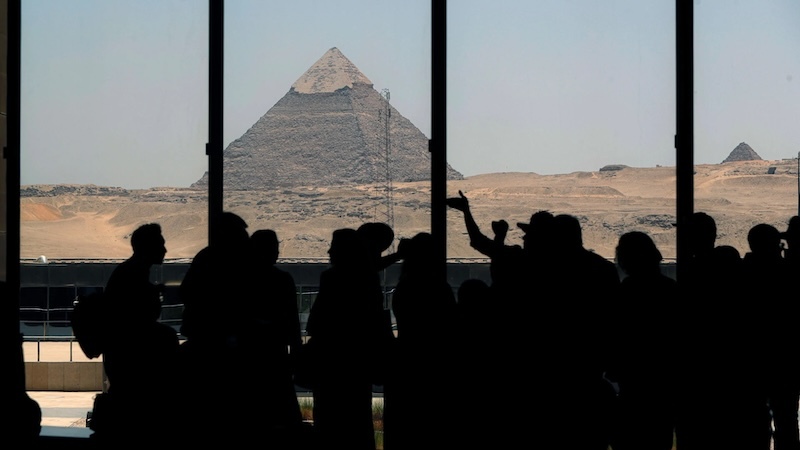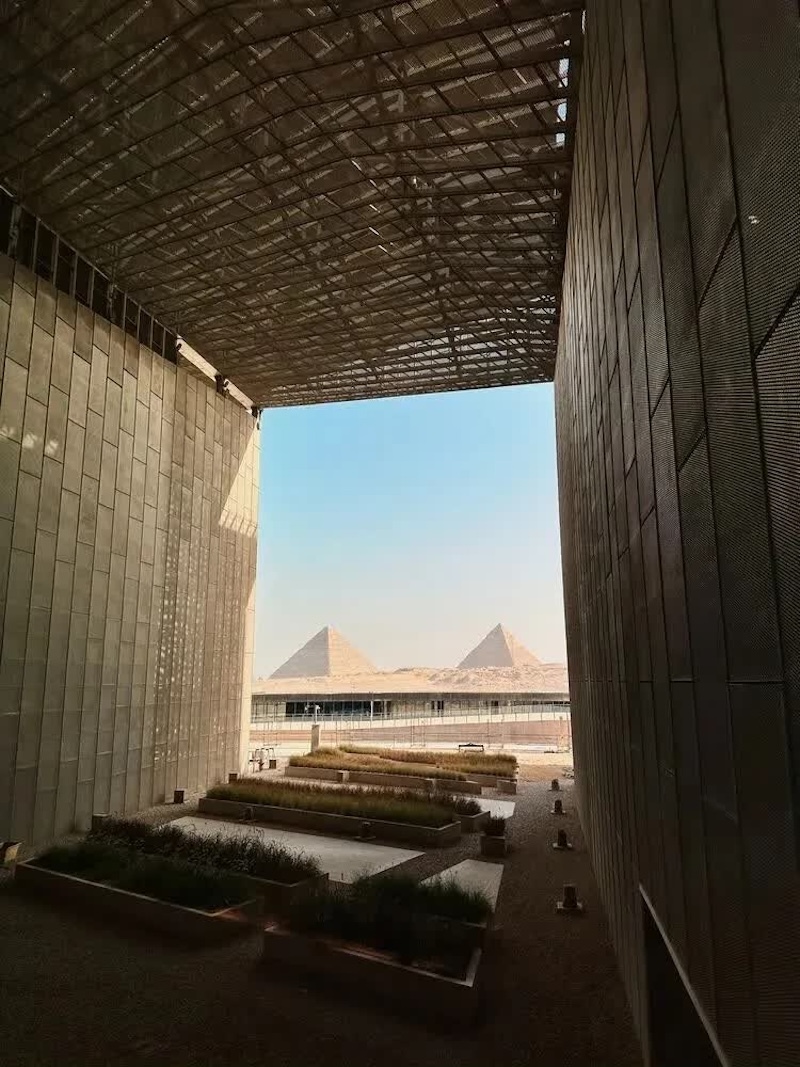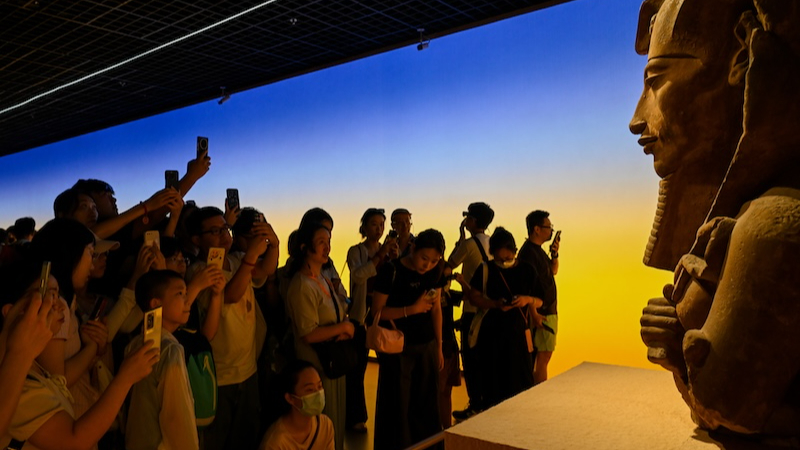
The Shanghai Museum's ancient Egyptian civilization exhibition is coming to an end, and in Egypt, the Grand Egyptian Museum (GEM), which was originally scheduled to officially open in July, has been postponed again, and the full opening will be postponed to the fourth quarter of this year.
The Paper learned that the Grand Egyptian Museum, Egypt's largest cultural project, was selected in 2002 and construction began in 2005. The conservation and restoration studio has been in operation since 2010. The museum opened most of its exhibition halls last fall, but the most anticipated Tutankhamun exhibition hall has not yet been opened, apparently reserved for the highlight of its full opening at the end of this year.

View of the pyramids from the Grand Egyptian Museum.
Behind the surface of modern daily life in Egypt lies a visible reminder of a bygone era: geometrically silent, towering figures rise from the desert horizon, looming among the apartment buildings. Beige upon beige, striking against the blue sky. Confronting these 4,500-year-old man-made wonders, it's impossible to remain calm.

The top of the main building of the Grand Egyptian Museum is at the same height as the Pyramids of Giza.
Nearby, another, much more recent feat of engineering, the Grand Egyptian Museum, exudes a sense of majesty and order, setting it apart from the hustle and bustle of the capital. Nowhere else in Cairo can visitors walk for kilometers without being interrupted by car horns, persistent street vendors, or the scorching heat—let alone within a massive, temperature-controlled building built to international standards. Promotional banners and videos proclaim, "A new wonder is being born," drawing a comparison to the pyramids, the only surviving of the Seven Wonders of the Ancient World.

The Grand Egyptian Museum is expected to attract 5 million visitors a year.
The Grand Egyptian Museum, expected to open fully by the end of 2025, is the centerpiece of the entire archaeological site reconstruction project, but the entire project has been time-consuming and arduous.
The idea for the museum was first proposed in 1992, but it wasn't until January 2002 that the Egyptian government announced a global design competition for a new museum complex to house, exhibit, and preserve the world's greatest ancient treasures. The following month, a site was chosen, just two kilometers from the Giza Pyramids in Cairo.
In 2003, at a press conference in Cairo, Heneghan Peng Architects, an Irish-based firm, was announced as the winner of an architectural competition to create a new "Grand Egyptian Museum" with a strikingly modern design.

Exterior of the Grand Egyptian Museum
Construction officially began in 2005, but the ambitious project quickly encountered environmental, financial, and political challenges, leading to significant delays. It wasn’t until 2014 that the project got back on track, and with the support of an international loan, construction was able to proceed.
The Egyptian government announced the museum's public opening in 2018 and 2019. After the initial opening date was postponed, and then again due to the global COVID-19 pandemic, it was expected to be fully open to the public by mid-2024. But this vision has once again been dashed.

In 2018, a granite statue of Ramses II was transported to the Grand Egyptian Museum.
The opening ceremony was subsequently postponed to July 3, 2025. However, in June, Egypt's prime minister announced that the full opening of the museum would be postponed until the fourth quarter of 2025 due to the war between Israel and Iran. A statement from the Egyptian Ministry of Tourism and Antiquities said: "This decision reflects Egypt's sense of responsibility and its commitment to hosting a truly outstanding global event in an atmosphere worthy of the magnificent legacy of ancient Egyptian civilization."

Granite statue of Ramses II in the Grand Egyptian Museum.
Undoubtedly, after more than two decades and over a billion dollars in investment, the Grand Egyptian Museum is now the world's largest museum dedicated to a single civilization. Encompassing 500,000 square meters of meticulously manicured gardens, it rivals the pyramids in sheer size.
Currently, about 100,000 items have been collected from storage sites and local museums, including artifacts from prehistoric times, the long Pharaonic civilization, and ancient Greek and Roman periods. Since the autumn of 2024, the Grand Egyptian Museum has been open to the public in phases.

The Grand Egyptian Museum's exhibition halls are now open.
"This is one of the best exhibitions in the world," said Marika Antoun, an Egyptian doctor. She is passionate about the pharaonic era and is well-versed in the Egyptian collections at the British Museum and the Louvre. As an amateur archaeologist, Antoun believes the Grand Egyptian Museum rivals these world-class museums. This was her third visit, and as an Egyptian, she only had to pay about $4.40 for admission—one-seventh the price for foreign tourists. Even so, this price is still relatively high for most Egyptians outside the upper-middle class.

The Egyptian Museum in Cairo's Tahrir Square will continue to operate.
The museum is now almost ready, with only the final step left: transporting Tutankhamun's golden treasures from the Egyptian Museum in Cairo to the new building.
In Cairo, those famous artifacts—Tutankhamun's golden mask and his intricately inlaid throne—are still awe-inspiring, even though they're scattered across small, dimly lit, and overcrowded galleries. They will undoubtedly be even more impressive once they're displayed alongside Tutankhamun's 5,000 other funerary objects at the Grand Egyptian Museum. The old museum in Cairo, a slightly dated, pink palace-like structure built in 1901 as Africa's largest museum at the time, will remain open to the public and continue to house and display less eye-catching but still valuable artifacts, such as those unearthed from the royal tomb of Tanis, which are every bit as magnificent as those found in Tutankhamun's tomb.

Many artifacts from the Egyptian Museum, including those from the reign of Tutankhamun, have been or will be moved to the Grand Egyptian Museum.
The Grand Egyptian Museum, a sleek, wedge-shaped building with a sharp, limestone facade covered in nested pyramidal patterns, looks a bit like an airport or a shopping mall. Under the shade of palm trees, uniformed museum staff are energetic and golf carts carry tourists around.

In the vast museum, the 11-meter-tall statue of Ramses II doesn't look huge by comparison.
The interior is breathtakingly vast. The main atrium is so vast that it practically engulfs its centerpiece: a statue of Ramses II. This 3,200-year-old statue, standing 11 meters tall and weighing 83 tons, was discovered in fragments near ancient Memphis in 1820. This visual contrast reveals the dilemma faced by a contemporary "temple" when displaying ancient monuments: these artifacts were designed to overwhelm their surroundings—and they have indeed achieved this purpose for centuries. This sense of overwhelming power should not be diminished in museum presentation. Fortunately, the museum's grand staircase successfully captures this tension. Its monumental scale, yet minimalist and restrained, rises step by step, forming a stage that guides visitors past statues, sarcophagi, and stelae, as if ascending from ancient times. This fusion of ancient and new is as natural as the Giza skyline. At the end of the staircase, a viewing platform offers a panoramic view of the magnificent pyramids. The Grand Egyptian Museum is breathtaking through sheer scale.

The Grand Staircase at the Grand Egyptian Museum.

A tourist looks out at the Giza pyramid complex at the Grand Egyptian Museum.
The exhibition halls are a series of open spaces arranged along the same slope as the Grand Staircase. The visitor's flow follows this path, progressing chronologically from prehistory to the Greco-Roman period, passing through the Middle Kingdom and the New Kingdom. Each era is further divided into three vertical themes: "Society," "Kingdom," and "Faith," encompassing a total of 12 halls.

Artifacts from ancient Egypt are exhibited in twelve halls, most of which are already accessible to the public.
Faced with Egypt's dazzling array of pottery, coffins, figurines, and hieroglyphically inscribed artifacts, it's easy to feel overwhelmed. However, thanks to careful curatorial effort, these objects are organized into carefully constructed visual units that, while somewhat symmetrical in form, are nonetheless captivating. Large transparent display cases layer adjacent objects, creating rich visual relationships. A highlight is a group of 40 miniature wooden soldier models found in the tomb of Mesehti, a provincial governor, from the late First Intermediate Period (c. 2181–2055 BC, a roughly 100-year period between the Old Kingdom and the Middle Kingdom). These funerary objects, intended to protect the deceased in the afterlife, offer a rare glimpse into ordinary members of society at the time. The soldiers, with their neatly cropped hair, armed with spears and shields, and wearing short, easy-to-move kilts, stand in elegant contrast to the solemn black sarcophagus beside them.

This set of ancient Egyptian soldier models was unearthed in the tomb of Mesehti, a local governor of the Asyut region from the late First Intermediate Period to the early Middle Kingdom.
The exhibition hall has no fixed route for visitors, presenting a rare "non-teaching" experience. The text on the wall may be a bit brief, but when conditions permit, it always tries to give the exhibits a "human" dimension. For example, a cracked wooden mallet is placed next to an unfinished and slightly rough statue, which reminds people of the ancient craftsmen who once held tools and worked day after day. Fragmented papyrus manuscripts are usually difficult to recognize, but at the Grand Egyptian Museum, they are exhibited next to a set of scribes' tools - ink trays, ink reservoirs, and polishers for fixing pigments - a group of still lifes that silently tell the skills and daily lives of ancient writers.

An Egyptologist works next to Tutankhamun's gilded coffin as it undergoes an eight-month restoration process, the first since the tomb was discovered in 1922.
Last year, Egypt welcomed over 15 million tourists. With the opening of the Grand Egyptian Museum, the Egyptian government hopes to double that number to 30 million annually by 2030. This museum is the perfect place to package ancient Egypt into a four-hour experience, perfect for a pre-holiday cultural adventure. This ambitious project is clearly a tribute to a civilization whose extraordinary power has captivated audiences worldwide.

The Grand Egyptian Museum at night, its architecture reminiscent of the nearby pyramids.


